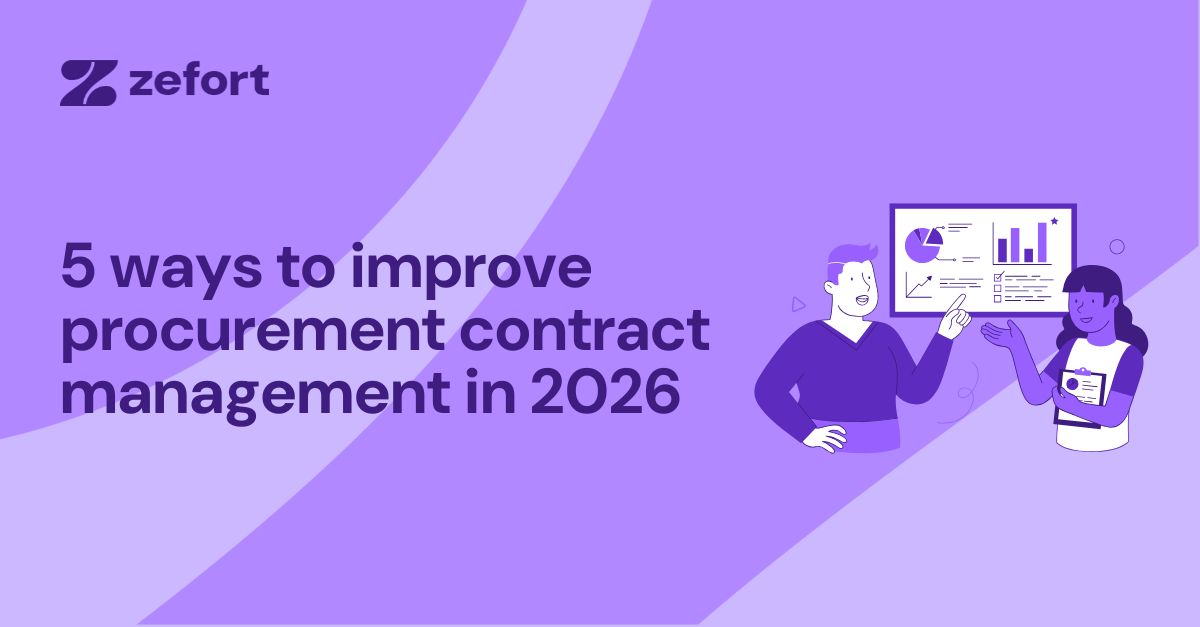Unlocking Efficiency: A Guide to Contract Lifecycle Management Software
Contracts are the backbone of business relationships, guiding everything from partnerships and sales agreements to employee engagements. But let’s face it, managing these crucial documents can be like searching for a needle in a haystack. Hours spent pouring over paperwork, endless back-and-forths with stakeholders, and the constant fear of missing key deadlines can leave even the most organized professionals feeling overwhelmed.
Enter contract lifecycle management software, the knight in shining armor that promises to streamline the entire process. In this guide, we’ll unravel the mysteries of this innovative solution, unlocking the efficiencies and perks it offers to businesses of all sizes. So, grab your virtual magnifying glass, and let’s embark on a journey to discover how contract management software can revolutionize your organization’s operations.
What is Contract Lifecycle Management Software?
Contract Lifecycle Management (CLM) software is a tool designed to streamline and automate the entire contract management process. It enables organizations to create, negotiate, track, and manage contracts more efficiently. With CLM software, businesses can reduce manual errors, improve compliance, and enhance contract visibility.
For example, the software can generate automated alerts for critical contract milestones and renewal dates, ensuring that important deadlines are not missed.
Additionally, CLM software centralizes contract data, making it easily accessible for all relevant stakeholders, increasing collaboration and reducing redundancies.
Benefits of Contract Lifecycle Management Software
Contract Lifecycle Management software provides several key benefits for businesses.
Firstly, it streamlines the contract management process, reducing the need for manual tasks and improving efficiency. This not only saves time but also reduces the risk of errors.
Secondly, CLM software enhances contract visibility, allowing businesses to track important dates, deadlines, and obligations more easily. This helps companies ensure compliance and avoid costly penalties. Lastly, CLM software improves collaboration and communication within an organization and with external parties, facilitating smoother negotiations and reducing misunderstandings.
Key Features of Contract Lifecycle Management Software
Document Generation and Automation
Document Generation and Automation is a core feature of Contract Lifecycle Management Software. It streamlines the creation and management of contracts, reducing manual effort and increasing efficiency.
- This functionality allows users to quickly generate contracts with pre-defined templates, saving time and ensuring consistency.
- Automation features enable the system to automatically populate contract clauses and terms, reducing the risk of errors and omissions.
- Document Generation and Automation also facilitates collaboration among multiple stakeholders by providing easy access to the latest version of the contract.
- By automating routine tasks like document generation and revision, organizations can allocate resources to more strategic activities, leading to improved productivity and cost savings.
Contract Authoring and Collaboration
Contract authoring and collaboration are integral components of contract lifecycle management software. This software offers a user-friendly platform for creating and editing contracts while facilitating seamless collaboration among stakeholders. With contract authoring and collaboration features, teams can work together in real-time, ensuring efficient and accurate contract creation.
For instance, multiple users can simultaneously review, comment, and make edits on a contract document, eliminating the need for back-and-forth email exchanges. Moreover, version control capabilities allow users to track changes and maintain transparency throughout the contract drafting process.
Contract Repository and Organization
Contract Repository and Organization is a crucial component of Contract Lifecycle Management Software. It enables businesses to store, manage, and search for contracts in a centralized and easily accessible system. This helps in reducing manual effort, improving efficiency, and ensuring compliance with contractual obligations.
For example, it allows users to quickly locate specific contracts or specific terms within a contract, eliminating the need to manually search through paper documents or multiple digital folders.
Additionally, a well-organized contract repository can aid in analyzing contract performance, identifying trends, and making data-driven decisions.
Contract Approval Workflow
Contract approval workflow streamlines the process of reviewing and approving contracts, ensuring efficiency and reducing errors. By automating the workflow, organizations can save time and improve collaboration among stakeholders.
For example, the software can automatically route contracts to the appropriate individuals for review and approval, with notifications and reminders to ensure timely action. It also provides a centralized platform for tracking the status of contracts, allowing organizations to easily monitor progress and identify bottlenecks. Implementing a well-designed contract approval workflow can enhance productivity and minimize risks in contract management.
Contract Tracking and Analytics
Contract tracking allows organizations to efficiently monitor contract progress, ensuring timely execution and minimizing risks. Analytics, on the other hand, provide valuable insights into contract performance and trends, enabling data-driven decision-making.
For example, through tracking and analytics, companies can identify patterns of contract delays or renegotiation, allowing them to optimize future contract processes. By leveraging these features, organizations can improve their overall contract management efficiency and effectiveness.
Choosing the Right Contract Lifecycle Management Software
Identifying Your Organization’s Needs
Identifying your organization’s needs is the first step in selecting contract lifecycle management software. Assess your current contract management process, and identify pain points and areas for improvement.
For example, if your contracts are stored in multiple locations and are difficult to access, you may need software that offers centralized contract storage and easy retrieval. Consider the features that are most important to your organization, such as contract drafting, approval workflows, and integration with existing systems. By understanding your specific requirements, you can choose a CLM solution that aligns with your needs and maximizes efficiency.
Evaluating Different Contract Lifecycle Management Software
When evaluating different contract lifecycle management software, it’s important to consider factors such as user-friendliness, customization options, and integration capabilities. A user-friendly interface allows for easy adoption and minimizes the learning curve for employees. Customization options ensure that the software aligns with specific business needs and workflows.
Additionally, integration capabilities enable seamless connections with other essential systems, like CRM or ERP software.
For example, a company may require the ability to automatically populate contract data from their CRM system. Evaluating these features and considering how they will enhance contract management processes is crucial to choosing the right software.
Considering Integration and Scalability
Integration and scalability are significant factors to consider when selecting contract lifecycle management software. Integration capabilities allow the software to seamlessly connect with other systems and software used within the organization, enabling smooth data flow and minimizing manual data entry. Scalability ensures that the software can handle increasing volumes of contracts and users as the organization grows.
For example, a company may require the software to integrate with their existing CRM system to automatically update customer information when a contract is signed.
Additionally, scalability is important to accommodate future expansion without the need to switch to a new software platform.
Examining Security and Compliance Measures
Implementing robust security measures is imperative when considering Contract Lifecycle Management software. Encryption and access controls are essential to protect sensitive data from unauthorized access. Compliance with industry regulations and data privacy laws should also be a top priority.
For example, ensuring the software adheres to GDPR guidelines is crucial when handling personal information. Regular audits and vulnerability assessments can identify potential weaknesses in the system, allowing for prompt resolution.
Additionally, user training and awareness programs on security best practices can mitigate human errors and enhance overall system security.
Reviewing Customer Support and Training Options
When selecting contract lifecycle management software, it is important to carefully review the available customer support and training options. Solid customer support ensures prompt assistance in resolving any issues that may arise during implementation or daily use. Look for software providers offering multiple channels of support, such as phone, email, and chat, as well as extensive documentation and a dedicated support team.
Additionally, comprehensive training programs help users quickly learn the software and maximize its potential. Look for providers that offer both initial onboarding training and ongoing training resources, such as webinars or tutorials, to ensure users have the knowledge and skills needed to effectively utilize the software.
Implementation and Adoption of Contract Lifecycle Management Software
Creating an Implementation Strategy
When creating an implementation strategy for contract lifecycle management software, it is important to focus on practical steps that can be taken to ensure successful deployment. Here are some tips to consider:
- Set clear goals and objectives: Define what you want to achieve with the software, such as streamlining contract processes or improving compliance.
- Assess current processes: Evaluate the existing contract management procedures to identify pain points and areas for improvement.
- Identify key stakeholders: Determine who will be involved in the implementation process and engage them early on to gain their support and commitment.
- Develop a timeline and action plan: Create a detailed roadmap with specific milestones and tasks to guide the implementation process.
- Allocate resources effectively: Determine the necessary budget, personnel, and infrastructure required for a smooth implementation.
- Provide comprehensive training: Ensure that users receive proper training on how to effectively utilize the software to maximize its benefits.
- Monitor and evaluate progress: Continuously monitor the implementation process and assess its success against the defined goals, making necessary adjustments as needed.
Data Migration and System Integration
Data migration and system integration are crucial components of implementing contract lifecycle management software. When migrating data from existing systems, it is important to ensure the accuracy and completeness of the transferred information. Mapping data elements and reconciling any discrepancies is necessary for a smooth transition.
System integration allows for seamless connectivity between the contract management software and other existing software applications, enabling streamlined workflows and data sharing.
For example, integrating with ERP systems can automate the flow of information from procurement to contract creation. Both data migration and system integration require meticulous planning and testing to achieve optimal results.
Training and Change Management
Training and change management are crucial for successful implementation of Contract Lifecycle Management software. Employees should receive thorough training on the functionalities and features of the software to ensure effective usage.
Additionally, change management strategies should be employed to address any resistance to adopting the new system. This could involve communicating the benefits of the software, providing ongoing support, and soliciting feedback from users. Practical examples include conducting training workshops, creating user manuals, and assigning a dedicated team to assist with any issues or questions that arise during the transition period. Remember, successful training and change management are key to maximizing the benefits of CLM software.
Monitoring and Continuous Improvement
Monitoring and continuous improvement are vital for effective contract lifecycle management software. By regularly tracking and analyzing the software’s performance, organizations can identify areas for enhancement and address any issues promptly. For instance, monitoring can involve evaluating the software’s user-friendliness and adoption rates, ensuring a smooth workflow for contract creation, execution, and renewal.
Moreover, continuous improvement can entail incorporating user feedback and making incremental updates to enhance functionalities and address user needs. By prioritizing monitoring and continuous improvement, organizations can optimize their contract management processes and achieve better efficiency and effectiveness.
Wrapping up
Contract Lifecycle Management software offers a practical solution to streamline and optimize the contract management process. This guide explores the benefits of CLM software and explains how it can enhance efficiency in various stages of the contract lifecycle. From contract creation and negotiation to execution, monitoring, and renewal, CLM software offers automation and digitization features that save time, reduce errors, and minimize risks.
By centralizing contract data, providing real-time visibility, and automating tasks, CLM software empowers organizations to make strategic decisions, mitigate compliance risks, and improve overall contract management efficiency.





